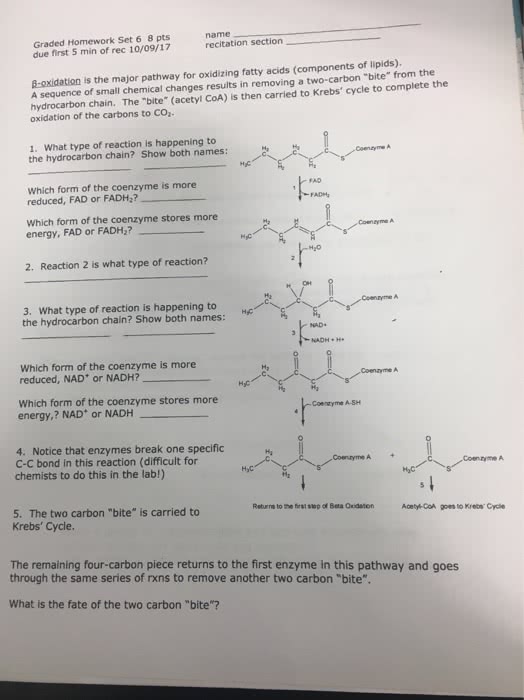1. Which is the immediate product of an anaplerotic reaction related to the Krebs cycle?
A) Citrate. B) Malate. C) Oxaloacetate. D) Acetyl CoA. E) Pyruvate.
A) The pathway converts glucose to lactate.
B) The pathway is called âanaerobicâ because no oxygen is consumed.
C) The pathway produces ATP and this is called substrate-level phosphorylation.
D) Substrate-level phosphorylation is a synonym for oxidative phosphorylation.
E) The NADH made in one part of the pathway is used up in another part of the
pathway.
2. The free energy stored in the high-energy bonds of ATP is obtained by the oxidation of fuels (carbohydrates, fats, proteins). Which of the following is NOT part of this process?
A) The conversion of carbohydrates, fats and proteins into acetyl CoA and the oxidation of Acetyl CoA in the TCA cycle.
B) The reduction of NAD+ and FAD by the TCA cycle.
C) The oxidation of NADH and FADH2 by the electron transport chain.
D) The pumping of hydrogen ions into the mitochondria from the cytoplasm using the
energy of the electron transport chain.
E) The synthesis of ATP from ADP and Pi by ATP synthase using the energy in the
proton gradient.
3. In some tissues, an increase in blood insulin will substantially increase the glucose transporters in the cell membrane and the transport of glucose into cells. Which of these tissues react in this manner?
A) Red blood cells and brain.
B) Brain and liver.
C) Liver and muscle.
D) Muscle and adipose.
E) Adipose and red blood cells
1. Which is the immediate product of an anaplerotic reaction related to the Krebs cycle?
A) Citrate. B) Malate. C) Oxaloacetate. D) Acetyl CoA. E) Pyruvate.
A) The pathway converts glucose to lactate.
B) The pathway is called âanaerobicâ because no oxygen is consumed.
C) The pathway produces ATP and this is called substrate-level phosphorylation.
D) Substrate-level phosphorylation is a synonym for oxidative phosphorylation.
E) The NADH made in one part of the pathway is used up in another part of the
pathway.
2. The free energy stored in the high-energy bonds of ATP is obtained by the oxidation of fuels (carbohydrates, fats, proteins). Which of the following is NOT part of this process?
A) The conversion of carbohydrates, fats and proteins into acetyl CoA and the oxidation of Acetyl CoA in the TCA cycle.
B) The reduction of NAD+ and FAD by the TCA cycle.
C) The oxidation of NADH and FADH2 by the electron transport chain.
D) The pumping of hydrogen ions into the mitochondria from the cytoplasm using the
energy of the electron transport chain.
E) The synthesis of ATP from ADP and Pi by ATP synthase using the energy in the
proton gradient.
3. In some tissues, an increase in blood insulin will substantially increase the glucose transporters in the cell membrane and the transport of glucose into cells. Which of these tissues react in this manner?
A) Red blood cells and brain.
B) Brain and liver.
C) Liver and muscle.
D) Muscle and adipose.
E) Adipose and red blood cells

